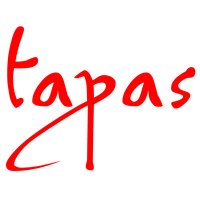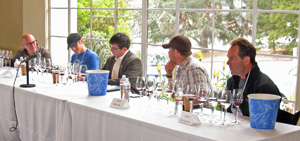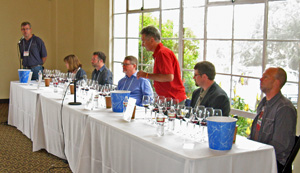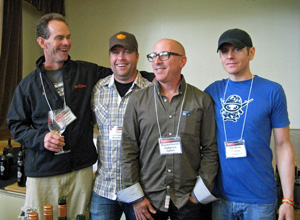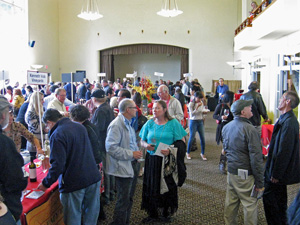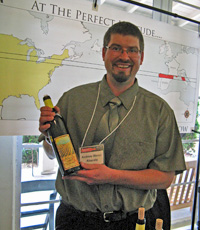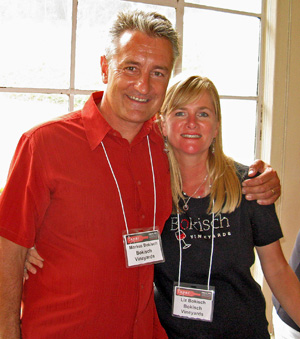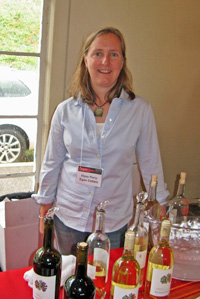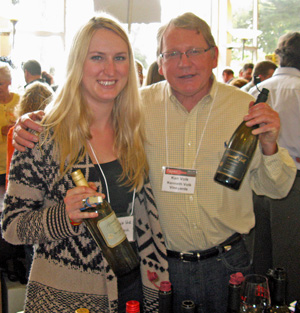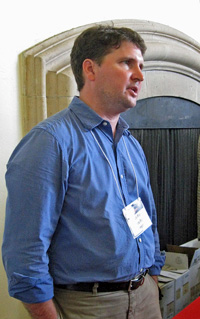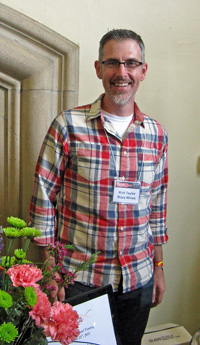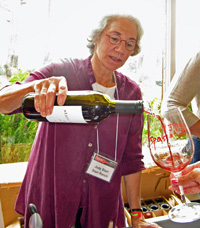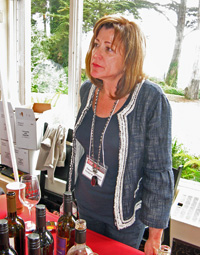Abacela Vineyards and Winery
Abacela 2012 Albariño, Estate, Umpqua Valley, Southern Oregon. Very light color, this displayed bright green apple and citrus aromas with a touch of spice. Medium-light bodied with vibrant acidity and a clean, fresh finish, nice.
Abacela 2012 Grenache Rosé, Estate, Umpqua Valley, Southern Oregon. Whole-cluster pressed. Light pink color, with strawberry and citrus peel plus spice on the nose. Bright mouthfeel with a long crisp finish, nice.
Abacela 2010 Tempranillo, Umpqua Valley, Southern Oregon. Made for early drinking, this was aged in mostly American oak, and bottled under screwcap. Medium-light color, this showed lots of upfront ripe plum and black cherry fruit, along with earth and dried herb notes. Medium-bodied with moderate tannins.
Abacela 2009 Tempranillo, Estate, Umpqua Valley, Southern Oregon. 95% Tempranillo, 2.5% Syrah, 2.5% Petit Verdot. Aged in 95% French oak and 5% American oak, with about 20% new barrels. Medium-dark color, featuring ripe black cherry fruit with hints of stone fruit, spice, and a stony/minerally note. Medium-light weight on the palate with plenty of structure and a grippy finish, nice.
Comments: Earl and Hilda Jones planted the first Tempranillo in the Pacific Northwest in 1995, and have been leaders among wineries making wine from Iberian grape varieties ever since. Earl was one of the founders of TAPAS and its first president. Winemaker Andrew Wenzl poured the Abacela wines, one of the day’s strongest line-ups.
Arizona Stronghold
Arizona Stronghold Site Archive 2011 Malvasia, Cochise County, Arizona. Light yellow color, this had very perfumed/floral aromatics along with tropical fruit. Lighter-bodied with moderate acidity on the palate but a bright finish.
Arizona Stronghold Site Archive 2010 Mourvèdre, Cochise County, Arizona. Made with partial whole-cluster fermentation. Medium purple color, displaying bright plum and black cherry, earth, black pepper, a slight floral note, and lots of spice. Medium-light weight and lively with chalky tannins on the finish, nice.
Comments: Winemaker Tim White was on hand to pour the Arizona Stronghold wines. The winery was founded by Eric Glomski and Maynard James Keenan in 2007 and farms two vineyards in the area of Willcox in southeastern Arizona.
Bokisch Vineyards
Bokisch 2012 Albariño, Las Cerezas Vineyard, Mokelumne River-Lodi. 100% Albariño, made entirely in stainless steel. Light straw color, with bright apple and fresh herb aromas plus a touch of citrus. Medium-light bodied with a vibrant texture and a chalky mineral note on the finish, nice.
Bokisch 2012 Verdelho, Vista Luna Vineyard, Borden Ranch-Lodi. 100% Verdelho, made entirely in stainless steel. Light straw color, this showed tropical fruit and spice on the nose. A bit richer on the palate than the Albariño, with a crisp, clean finish.
Bokisch 2012 Garnacha Blanca, Vista Luna Vineyard, Borden Ranch-Lodi. 87% Garnacha Blanca, 13% Albariño, made entirely in stainless steel. Very light color, featuring more earthy notes as well as green apple, herbs, and a touch of lees. Medium-bodied with a smooth finish.
Bokisch 2010 Monastrell, Belle Colline Vineyard, Clements Hills-Lodi. 100% Monastrell, aged 18 months in French and American oak. Medium color, earthy and gamey aromas along with black cherry, herbs, and a stony mineral component. Medium weight on the palate with a lively mouthfeel and moderate tannins on the finish, nice.
Bokisch 2010 Tempranillo, Lodi. 85% Tempranillo, 15% Graciano, aged 18 months in French and American oak. Medium-dark color, with dark berry fruit, dried herbs, spice, and vanilla/oak aromas. Lively and nicely-structured, with a moderately grippy finish.
Bokisch 2010 Graciano, Lodi. 100% Graciano, sourced from Las Cerezas & Terra Alta vineyards, aged 18 months in French and American oak. Medium-light color, displaying plum and darker berry fruit, earth, black pepper, fresh herbs, and a touch of sweet oak. Medium-full bodied, with a minerally note on the palate and firm tannins. This could be quite nice with a bit more bottle age.
Comments: Both Markus and Liz Bokisch were behind the Bokisch table. One of California’s leaders among wineries specializing in Iberian grape varieties since the late 1990s, the Bokisch vineyards in the Lodi area are all farmed organically. Markus and Liz poured a strong group of wines at this year’s TAPAS tasting.
Caduceus Cellars
Caduceus 2011 “Dos Ladrones,” Graham County, Arizona. 50% each Malvasia and Chardonnay, made in both stainless steel and neutral oak. Light yellow color, featuring somewhat floral aromas along with pear and stone fruit and lees. Medium-bodied with a fairly rich finish – leaning more toward Malvasia on the nose but more toward Chardonnay in the mouth.
Caduceus 2010 “Sancha,” Cochise County, Arizona. 92% Tempranillo, 8% Grenache, co-fermented. Medium-dark color, this was earthy and not fruit-forward, with leather, spice, and vanilla/oak leading the way. Medium-full bodied with big chewy tannins on the finish, nice.
Comments: Caduceus is located in the Verde Valley in central Arizona, though fruit is sourced from various locations. Their first wines came from the 2004 vintage. Owner/winemaker Maynard James Keenan (he’s also a famed rock vocalist, best-known for his work with the band Tool) poured the Caduceus wines. Both of the Caduceus wines were good.
Callaghan Vineyards
Callaghan 2010 “Ann’s,” Arizona. 45% Grenache Blanc, 35% Verdelho, 20% Symphony. Light yellow-straw color, this had earthy and waxy components along with pear and stone fruit aromas. Medium-bodied and lively on the palate, with a tasty finish – distinctive wine that could be mistaken for a white Rhône, nice.
Callaghan 2010 “Back Lot,” Arizona. 50% Grenache, 25% Tempranillo, 25% Syrah, made from purchased fruit with 35% whole-cluster fermentation. Medium-light color, displaying a resiny oak note along with higher-toned upfront red fruits. Medium-bodied with milder tannins.
Callaghan 2009 “Claire’s,” Sonoita, Arizona. 55% Mourvèdre, 45% Grenache, aged in neutral puncheons. Medium purple color, black cherry fruit with spice and vanilla/oak on the nose. Medium weight on the palate with moderate tannins.
Callaghan 2007 “Padres,” Sonoita, Arizona. 58% Tempranillo co-fermented with 25% Petit Verdot and blended with 17% Cabernet Franc, aged in 100% new oak. Medium-dark purple with some bricking on the edges, this had very woody/oaky aromas, plus higher-toned fruit and spice. The woody notes came through in the flavors as well, and this finished with moderately grippy tannins.
Callaghan 2011 “Padres,” Sonoita, Arizona. 30% Tempranillo, 30% Graciano, 30% Petit Verdot, 10% Tannat. Medium-dark color, this featured a more resiny oak character along with more upfront dark fruit, earth, and dried herbs. More structured than the 2007, with a big tannic finish.
Comments: Established in 1990 and located in the mountains southeast of Tucson, Callaghan has long been one of Arizona’s leaders in Iberian-variety wines. Founder and winemaker Kent Callaghan was also the first winemaker for Dos Cabezas WineWorks, and is one of the most experienced growers and winemakers in the state.
Core Wine Company
Core 2008 “Elevation Sensation,” Alta Mesa Vineyard, Santa Barbara County. 82% Grenache, 18% Mourvèdre. Medium-light color, with red fruits, spice, black pepper, and a touches of earth and oak. Medium-bodied and lively, with firm tannins.
Core 2008 Mourvèdre, Alta Mesa Vineyard, Santa Barbara County. Medium purple color, this featured plum and darker fruit, dried herbs, earth, stony minerals, and undertones of sweet oak. Medium-full bodied and structured, finishing with chalky tannins, nice.
Core 2008 “Cuvée Fletcher,” Alta Mesa Vineyard, Santa Barbara County. 62% Mourvèdre, 38% Grenache. Medium color, showing ripe higher-toned black cherry, herb, and mineral aromas. Fairly round texture with grippy tannins that sneak up on the finish.
C³ 2007 Tempranillo, Laetitia Vineyard, Arroyo Grande Valley. 100% Tempranillo, about 10% whole-cluster fermentation, aged 52 months in 50% new French oak. Medium-dark color, with earth and tobacco/dried herb notes upfront and bright, ripe plum and spice in support. Medium weight on the palate with very big tannins on the finish.
Comments: Core’s Dave and Becky Corey poured their wines from both the Core and C³ labels. Alta Mesa Vineyard is located at over 3,000-foot elevation in far-eastern Santa Barbara County. The winery was launched in 2001, and they have been working with longer barrel-aging for the reds in recent years. I skipped the very good Core 2008 “Reserve” Grenache as I had already tasted it a couple of times in the past year.
Dancing Coyote Wines
Dancing Coyote 2012 Albariño, Clarksburg. Very light straw color, displaying bright apple and pear fruit plus hints of lemonpeel. Medium-light bodied with a vibrant mouthfeel and clean, crisp finish, nice.
Dancing Coyote 2011 Verdelho, Clarksburg. Very light straw color, this showed more of a stone fruit and tropical fruit profile plus touches of earth and lees. Medium weight on the palate with a rounder texture and finish than the Albariño.
Dancing Coyote 2010 Tempranillo, Sierra Foothills. Medium purple color, with ripe plum and darker berry fruit, earth, and spice on the nose. Medium-full bodied, with moderately grippy tannins on the finish.
Comments: Dancing Coyote was established in 2001, and has been pouring some very good wines – particularly whites – at TAPAS for a number of years. The whites are made entirely in stainless steel with no malolactic fermentation, and are all bottled under screwcap.
Derby Wine Estates
Derby 2011 “Project España White,” Paso Robles. 100% Albariño, made entirely in stainless steel with no malolactic fermentation. Light straw color, with bright and ripe stone fruit and pear plus some spice and earth. Medium-bodied with a lively mouthfeel and finish.
Derby 2010 “Project España Red,” Paso Robles. 63% Tempranillo, 15% Grenache, 14% Carignane, 8% Graciano, aged 32 months in 63% once-used and 37% neutral barrels. Medium purple color, this displayed red fruit and earth with touches of smoke, tobacco, and vanilla/oak. Fairly rich on the palate with moderate tannins.
Comments: Derby’s Steve and Tiffinee Vierra were on hand to pour the Derby wines. Steve manages the vineyards while Tiffinee is the winemaker. The Project España wines are new to Derby, and though these didn’t quite make my favorites list, they were both strong candidates. Derby’s Westside Paso Robles vineyard was originally planted in the late 1990s, with Iberian varieties added about ten years later.
Dos Cabezas WineWorks
Dos Cabezas 2012 “Pink,” Cochise County, Arizona. From Garnacha and Monastrell, made in concrete and neutral oak. Very light pink/salmon color, this had upfront ripe stone fruit aromas and a touch of spice. Medium-light bodied with a fairly smooth mouthfeel and finish.
Cimarron 2010 “Rojo del Sol,” Cochise County, Arizona. 50% Tempranillo, 25% each Garnacha and Monastrell. Medium color, with plum and black cherry fruit plus earth and spice notes. Medium-light weight on the palate, with milder tannins.
Dos Cabezas 2009 “El Campo,” Pronghorn Vineyard, Sonoita, Arizona. Field blend composed mainly of Tempranillo and Mourvèdre, plus Petit Verdot, Aglianico, Syrah, Petit Sirah, Touriga, and Roussanne. Medium-dark color, this showed plum and blueberry, earth, a touch of dried herbs, lots of spice, and vanilla/earth. Structured and bold, with a chewy tannic finish.
Dos Cabezas 2009 “Águileón,” Cimarron Vineyard, Cochise County, Arizona. 95% Tempranillo, 3% Petit Verdot, 1% Souzão, 1% Tinta Cão, made in mostly French oak with about 10-15% American oak. Medium-dark color, with upfront vanilla/oak, ripe dark fruits and spice. Fairly full-bodied, with moderately grippy tannins.
Dos Cabezas 2010 “Boxcar,” Cimarron Vineyard, Kansas Settlement, Arizona. Fortified dessert wine, from 33% Tempranillo, 20% Petite Sirah, 17% Monastrell, 12% Tinta Cão, 9% Souzão, 9% Aleatico, fortified on the skins and aged in neutral barrels. Dark color, displaying somewhat floral aromas plus ripe plum and darker fruits, black pepper, and chocolate. Rich and sweet, with a finish that was on the shorter side.
Comments: Dos Cabezas, established in 1995 in southeastern Arizona, has been producing some notable wines for a number of years. Winemaker Todd Bostock and his family purchased the winery in 2006, and he poured his wines at TAPAS. Fruit comes from the winery’s Pronghorn Vineyard and from Cimarron Vineyard, owned by noted Oregon vintner Dick Erath.
Dubost Winery
Dubost 2009 “Crianza,” Paso Robles. 40% each Tempranillo and Syrah, 20% Grenache, aged in 25% new American oak. Medium purple color, this featured ripe red fruits, herbs, lots of spice, and undertones of vanilla/oak. Medium-light bodied, with lively acidity and fine tannins on the finish.
Dubost 2009 Tempranillo, Central Coast. Aged for 34 months in 40% new French oak. Medium color, showing ripe plum, spice, earth, and sweet oak on the nose. Medium weight on the palate with a bright mouthfeel and moderate tannins.
Comments: Dubost is located in the Adelaida Hills west of Paso Robles. The Dubost family have lived on the property since the 1880s, and launched their winery in 2002. Tempranillo is one of the winery’s specialties, and much of the fruit has been sourced from Starr Ranch, just a short distance up the road.
Egan Cellars
Egan 2011 Albariño, Terra Alta Vineyard, Lodi. Made entirely in stainless steel. Light straw color, with bright apple and stone fruit plus fresh herbs and a touch of lemonpeel. Lively mouthfeel and crisp finish, nice.
Egan 2012 Albariño, Terra Alta Vineyard, Lodi. Made in 50% stainless steel and 50% neutral oak. Light straw color, this featured citrus aromas and a slight floral note. Creamier texture than the 2011 bottling, but retaining good acidity and a clean finish.
Egan 2012 Vermentino, Las Lomas Vineyard, Carneros. Made entirely in stainless steel. Light straw color, showing pear and stone fruit along with some spice and earth notes. Bright on the palate with a zippy acidity and fresh finish, nice.
Egan 2011 Tempranillo, Liberty Oaks Vineyard, Lodi. Aged in about 50% each older French and American oak. Medium purple color, this had lots of forward plum and darker fruit plus spice aromas, with earth and dried herb/tobacco in the background. Medium-bodied with good structure and a moderately grippy tannic finish.
Comments: Egan was one of the newest producers at this year’s TAPAS, with 2011 being their inaugural vintage. They specialize in Spanish and Italian varieties. Winemaker Elyse Perry and her husband Jeff were on hand to pour their wines at the tasting, and they presented a strong line-up, particularly the whites. Though they’re just getting started, Egan should be a winery to watch.
Folin Cellars
Folin 2012 Grenache Rosé, Folin Vineyards, Rogue Valley, Oregon. Cold-soaked for seven days, then pressed to stainless steel and one neutral barrel. Light salmon/pink color, with strawberry and herb notes plus touches of earth and spice. Medium-light bodied, with a slight tannic bite on the finish.
Folin 2009 Tempranillo, Folin Vineyards, Rogue Valley, Oregon. Aged 24 months in about 25% new French oak. Medium-light color, featuring bright red fruit with floral, herbal, and stony mineral components and a touch of sweet oak. Vibrant mouthfeel with a lively finish and moderate tannins, nice.
Folin 2007 Tempranillo, “Reserve,” Folin Vineyards, Rogue Valley, Oregon. Aged 36 months in 100% new French oak. Medium color, with more upfront vanilla/oak plus ripe plum and spice on the nose. Bigger structure than the previous wine, with a grippy tannic finish.
Comments: Owner/winemaker Rob Folin was behind the winery table again this year. All the Folin wines come from estate-grown fruit in the Rogue Valley of southern Oregon. Folin is one of the few American producers using Vino-Lok glass closures for their wines. Folin has poured some solid wines at TAPAS over the years, and this year was no exception – their 2009 Tempranillo was a standout and the Grenache Rosé was quite good as well.
Gordian Knot Winery
Gordian Knot 2011 Albariño, Russian River Valley. Made entirely in stainless steel. Very light color, with stone fruit, and lemonpeel aromas, plus a touch of spice. Bright mouthfeel with a clean, crisp finish, nice.
Gordian Knot 2012 Albariño, Russian River Valley. Made entirely in stainless steel. Very light straw color, this featured riper fruit than the 2011 bottling. Medium-light weight with a rounder mouthfeel and finish.
Comments: Gordian Knot is a new venture launched in 2011 by Tim Meinken and Anne Giere, former proprietors ofSapphire Hill Vineyards & Winery. They currently produce the only Albariño from Russian River Valley fruit, and the 2011 bottling was particularly good.
|
Kenneth Volk Vineyards
Kenneth Volk 2011 Albariño, Riverbench Vineyard, Santa Maria Valley. About 30% malolactic fermentation. Very light color, with pear and white peach aromas plus an herbal note. Medium-bodied with a lively mouthfeel and finish.
Kenneth Volk 2010 Verdelho, Pomar Junction Vineyard, Paso Robles. Light straw color, this displayed citrus, spice, and a bit of earth. Medium-light weight with a bright mouthfeel and crisp, clean finish, nice.
Kenneth Volk 2009 Mourvèdre, Enz Vineyard, Lime Kiln Valley. From 80+ year-old, head-trained vines. Medium purple color, displaying ripe plum fruit along with earth, smoke, and herbs. Medium-bodied with good structure and moderately grippy tannins.
Kenneth Volk 2010 Tannat, Bella Collina Vineyard, Paso Robles. Medium-dark color, dark berry fruit, earth, and spice on the nose. Medium-bodied with juicy acidity and firm tannins, nice.
Kenneth Volk 2010 Touriga Nacional, Pomar Junction Vineyard, Paso Robles. Medium purple color, with earthy red fruits along with stone fruit and floral components. Medium weight on the palate with a lively mouthfeel and fine tannins on the long, clean finish, nice.
Comments: Ken Volk has long been a well-known proponent of lesser-knowngrape varieties in California, so it was no surprise that he presented a strong group of wines at TAPAS. Ken and his daughter Valentina poured the wines at the tasting, and the Verdelho and Touriga in particular were standouts.
Longoria Wines
Longoria 2011 Albariño, “Reserva,” Clover Creek Vineyard, Santa Ynez Valley. Destemmed and cold-soaked on the skins for 17 hours, then pressed into neutral French oak, with no malolactic fermentation. Light straw color, with citrus and stone fruit aromas plus a touch of fresh herbs. Medium-bodied and fairly rich on the palate, with a long, smooth finish.
Longoria 2010 Tempranillo, Santa Ynez Valley. 94% Tempranillo and 6% Merlot sourced from three vineyards, aged entirely in American oak, about 40% new. Medium purple color, this showed tobacco/dried herb aromas upfront, with black cherry, earth, spice, and some vanilla/oak in the background. Medium weight and lively in the mouth with good structure and fine tannins, nice.
Comments: Known as one of the pioneers of fine Santa Barbara County wine, Rick Longoria is better-known for Pinot Noir and other varieties but he has made excellent Albariño and Tempranillo over the past ten years. Rick was on hand to pour his wines, both of which were very good. This was the first time I had tasted his “Reserva” Albariño.
Pierce Ranch Vineyards
Pierce Ranch 2012 Albariño, San Antonio Valley. Made mostly in stainless steel, plus in one neutral barrel. Very light straw color, with stone fruit and orangepeel aromas. Medium-light bodied with a round mouthfeel and smooth finish.
Pierce Ranch 2011 Arinto, San Antonio Valley. Fermented in stainless steel and aged in neutral oak. Medium-light straw color, this had citrus and herb scents plus a slight floral component. Medium-light weight with bright acidity and a lively finish, nice.
Pierce Ranch 2009 “Cosecheiro,” San Antonio Valley. 53% Touriga, 40% Tempranillo, 5% Tinta Cão, and 2% Graciano. Medium purple color, displaying bright red and black fruits, spice, a stony mineral note, and a touch of sweet oak. Medium-full bodied with very good balance and structure, finishing with firm tannins, nice.
Pierce Ranch 2010 Tempranillo, “Reserve,” San Antonio Valley. Medium color, riper plum and blueberry fruit along with dried herbs and big spice and vanilla/oak elements. Big and structured on the palate, with a grippy tannic finish.
Pierce Ranch 2011 Graciano, San Antonio Valley. Medium-dark purple, this was less fruit-forward, with earthy black cherry fruit plus spice and iron/mineral notes. Medium-bodied with fairly big chewy tannins on the finish.
Comments: First planted in 1999, Pierce Ranch has become one of California’s top vineyards for Iberian grape varieties, and their own wines have been very solid over the years.All of the fruit comes from the Pierce Ranch estate vineyard in the San Antonio Valley of southern Monterey County. Josh Pierce was behind the winery table pouring the wines again this year.
Quinta Cruz
Quinta Cruz 2012 Albariño, Bokisch Vineyard, Clements Hills. Very light straw color, with subtle stone fruit, citrus, and herb aromas. Medium-light bodied with bright acidity and a stony mineral element on the crisp finish, nice.
Quinta Cruz 2011 Verdelho, Silvaspoons Vineyard, Alta Mesa. Very light straw color, this showed a floral note along with tropical fruit and a touch of spice. A bit richer in the mouth than the Albariño, with a smooth finish.
Quinta Cruz 2009 Touriga, Pierce Ranch, San Antonio Valley. 82% Touriga Nacional and 18% Touriga Franca. Medium purple color, displaying meaty/gamey aromas along with red fruits, earth, spice, and a floral note. Medium-bodied with moderate tannins, nice.
Quinta Cruz 2010 Graciano, Bokisch Vineyard, Clements Hills. 100% Graciano. Medium color, with earth and dark fruit along with dried herbs on the nose. More structured in the mouth, with a fairly grippy tannic finish.
Quinta Cruz 2009 Tempranillo, “Reserve,” Pierce Ranch, San Antonio Valley. 80% Tempranillo, 10% each Graciano and Grenache. Medium purple color, this showed earthy and slightly funky aromas, plus red fruits and dried herbs. Medium weight on the palate with firm tannins.
Quinta Cruz 2009 Souzão, Silvaspoons Vineyard, Alta Mesa. 100% Souzão. Dark purple color, featuring riper, more extracted dark berry fruit with earth and leather notes and vanilla/oak undertones. Big and bold, with chewy tannins on the finish.
Quinta Cruz 2007 “Rabelo” Dessert Wine, Late-Bottled Vintage, Pierce Ranch, San Antonio Valley. 50% Tinta Roriz, 34% Touriga Nacional, 16% Tinta Cão. Medium-dark ruby color, with ripe plum, spice, chocolate, and a touch of pepper. Medium-rich mouthfeel and moderately sweet, with a long, smooth finish.
Comments: Established in 2008 to showcase Iberian grape varieties, Quinta Cruz is the sister winery of well-known Santa Cruz Mountain Vineyard. They presented a good group of wines once again this year at TAPAS. Fruit is sourced from Pierce Ranch in southern Monterey County and from Bokisch and Silvaspoons vineyards in Lodi.
Riaza Wines
Riaza 2012 Verdejo, Heringer-Holland Vineyard, Clarksburg. Made entirely in stainless steel. Light straw color, this featured stone fruit, fresh herbs, and a leesy note on the nose. Medium-bodied with a long, tasty finish, nice.
Riaza 2011 Garnacha, Clements Hills-Lodi. Very light garnet color, with strawberry, spice, and sweet oak aromas. Medium-light weight in the mouth, with moderate tannins.
Riaza 2010 Tempranillo, Bray Vineyard, Amador County. Aged 22 months in 2-year old French and American oak. Medium color, with ripe red fruits, earth, spice, and a touch of oak. Medium-light bodied with a fairly lively mouthfeel and moderately grippy tannins.
Riaza NV “Viña Selecta,” California. Tempranillo, Graciano, and Garnacha sourced from Lodi, Amador, and Clarksburg, mostly from the 2010 vintage. Medium garnet color, displaying ripe black cherry, dried herbs, earth, and notes of black pepper and oak. Medium-bodied with more structure and tannin than the previous wines.
Riaza 2010 Graciano, Clements Hills-Lodi. 100% Graciano, aged entirely in French oak. Medium purple color, with bright red fruits, earth, tobacco, and lots of spice on the nose. Medium weight on the palate and structured, finishing with firm tannins, nice.
Comments: Rick and Erin Taylor established Riaza Wines in 2008, and they specialize in wines from Spanish varieties sourced from Lodi, Clarksburg and the Sierra Foothills. Rick poured a solid line-up of wines, and this is another newer winery that should be worth watching.
St. Amant Winery
St. Amant 2012 “Miss Independent” Verdelho, Amador County. Made entirely in stainless steel with no malolactic fermentation. Light straw color, with stone fruit and citrus aromas plus lightly floral scents. Medium-light bodied with a bright mouthfeel and a fresh, crisp finish, nice.
St. Amant 2010 “The Old Soldier” Touriga, Amador County. Blended with about 5% Tempranillo. Medium purple color, featuring earth, leather, and lots of spice plus ripe plum and darker berry fruit. Medium-bodied and fairly smooth, with moderate tannins.
St. Amant 2011 Souzão, Amador County. Blended with a little Tempranillo, made mostly in neutral oak. Vibrant medium-dark purple color, this showed bright red fruits, black pepper and spice, and a touch of sweet oak on the nose. Lively mouthfeel with firm tannins on the long finish, nice.
St. Amant 2010 “The Road Less Traveled” Tempranillo, Amador County. Medium garnet color, with blueberry, earth, dried herbs, and vanilla oak aromas. Big and structured on the palate with chewy tannins.
St. Amant NV Tawny Port, “Lot No. 6,” Amador County. 100% Bastardo, aged eight years in neutral oak. Fairly light brickish color, displaying ripe plum, brown sugar and caramel, and spice on the nose. Rich and moderately sweet, with good balancing acidity and a long finish.
Comments: St. Amant was established in 1981 by the Spencer family, and Stuart Spencer (current TAPAS president) and his mother Barbara were on hand again to pour their wines. The fruit for their Iberian-variety wines comes from the family’s vineyard in Amador County. The wines have been solid and consistent over the years, and their Tawny Port is always a favorite.
Six Sigma Ranch
Six Sigma 2009 Tempranillo, “Christian’s Reserve,” Lake County. 100% Tempranillo, aged 24 months in new French oak. Medium-dark color, this featured lots of upfront spice aromas, along with plum, vanilla/oak, and a stony/mineral note. Big and structured with grippy tannins on the finish.
Comments: Six Sigma proprietors Kaj and Else Ahlmann purchased their property in Lake County in 2000. Their estate vineyards are planted in the volcanic soil common to the area. Matt Hughes is the winemaker.
Starr Ranch
Starr Ranch 2011 Grenache, “Reserve,” Estate, Paso Robles. Medium-light color, with intense, ripe red fruits, spice, and sweet oak on the nose. Medium-bodied with good structure in the mouth, this finished with moderate tannins.
Starr Ranch 2010 “Orion,” Paso Robles. 61% Tempranillo plus Mourvèdre and Petit Verdot. Medium purple color, displaying earthy darker fruit aromas plus some dried herb/tobacco and smoky components. Medium-full bodied, this had a fairly grippy tannic finish.
Starr Ranch 2011 Tempranillo, Paso Robles. A little Petit Verdot blended in. Medium purple, this showed plummy and smoky aromas, along with vanilla/oak and a stony mineral note. Big and structured, with chewy tannins that will need time to soften.
Comments: Starr Ranch was planted in 2002 in the Adelaida Hills area west of Paso Robles. The vineyard includes Bordeaux, Rhône, and Iberian grape varieties, and they sell fruit to a number of local wineries. Starr Ranch began producing wine under their own label with the 2006 vintage. Judy Starr was behind the winery table at TAPAS.
Turkovich Family Wines
Turkovich 2012 Albariño, Yolo County. Made entirely in stainless steel. Very light color, with subdued stone fruit and spice aromas. Medium-bodied with a fairly smooth texture and finish.
Turkovich 2011 Grenache, California. 92% Grenache, 8% Tempranillo. Light garnet color, featuring red berry fruit and lots of rather woody vanilla/oak. Lively mouthfeel with medium tannins.
Turkovich 2010 Tempranillo, “Barrel Select,” Yolo County. Medium purple color, this showed higher-toned plum fruit, earth, and resiny oak. Medium-full bodied with a grippy tannic finish.
Comments: Established in 2007 by grower/winemaker Chris Turkovich and his family, the estate vineyard is located in the Winters area of Yolo County, just over the Vaca Mountains from Napa. The winery has focused mainly on wines made from Iberian, Rhône, and Bordeaux grape varieties.
Twisted Oak Winery
Twisted Oak 2012 “Calaveras Rosa,” Calaveras County. Rosé made from 100% Mourvèdre. Light salmon color, displaying herbs and ripe red fruit on the nose. Round mouthfeel and a smooth finish.
Twisted Oak 2009 Tempranillo, “Zilch,” Calaveras County. 100% Tempranillo, sourced from three vineyards. Medium-dark color, with ripe and upfront black cherry and plum fruit plus lots of vanilla/oak. Fairly rich and smooth on the palate and finish, with moderate tannins.
Comments: Twisted Oak was founded by Jeff Stai and his wife Mary in 2001, and the winery has been among the leaders in California wines made from Iberian grape varieties over the years. I had tasted a number of the Twisted Oak wines during a visit there late last year, so I limited my tasting to wines I had not tried before.
Verdad Wine Cellars
Verdad 2012 Grenache Rosé, Sawyer Lindquist Vineyard, Edna Valley. Made in 50% each stainless steel and neutral oak. Light pink/salmon color, with slightly floral aromas along with bright red fruit and stone fruit components. Lighter-bodied, with a clean and refreshing sensation on the palate and a crisp finish, nice.
Verdad 2012 Albariño, Paragon Vineyard, Edna Valley. Made entirely in neutral oak. Light straw color, showing stone fruit, herb, and lees notes. Fairly round mouthfeel with a long, smooth finish.
Verdad 2012 Albariño, Sawyer Lindquist Vineyard, Edna Valley. Made in 75% stainless steel and 25% neutral oak. Light straw color, this featured brighter stone fruit aromas than the previous wine, along with fresh herbs and a slightly saline/mineral quality. Medium-light bodied with brisk acidity and a lively finish, nice.
Verdad 2011 Graciano, Ibarra-Young Vineyard, Santa Ynez Valley. 85% Graciano, 15% Tempranillo, aged in neutral Hungarian puncheons. Medium purple color, showing earth and plum along with smoke and tobacco. Medium-bodied with moderate tannins on the finish.
Verdad 2010 Tempranillo, Sawyer Lindquist Vineyard, Edna Valley. 84% Tempranillo, 16% Grenache, aged 18 months in 30% new French oak. Medium-dark color, this had pretty floral notes on the nose plus plum and black cherry, earth, dried herbs, and a stony/mineral component. Medium-light bodied and structured on the palate, this finished with firm tannins, nice.
Comments: Louisa Sawyer Lindquist poured her Verdad wines, and she presented one of the strongest line-ups at the TAPAS tasting. Louisa and Verdad have been specializing in wines made from Iberian grape varieties since 2000. Sawyer Lindquist Vineyard in southern Edna Valley was planted in 2005 and is farmed biodynamically – its fruit has led to some outstanding wines in recent years.
Yorba Wines
Yorba 2009 Tempranillo, Shake Ridge Vineyards, Amador County. 95% Tempranillo, 5% Graciano, aged 10 months in 25% new French oak. Medium-dark color, with lots of upfront ripe fruit, spice, and vanilla/oak. This had a fairly round texture in the mouth, but big grippy tannins on the finish.
Yorba 2008 Tempranillo, Shake Ridge Vineyards, Amador County. 97% Tempranillo, 3% Graciano. Medium purple color, this displayed ripe black cherry and plum fruit, earth, and vanilla/oak aromas. Fairly rich and smooth on the palate and finish with moderate tannins.
Comments: The Kraemer family runs Yorba, with noted vineyard manager Ann Kraemer farming their Shake Ridge Vineyards, which sells fruit to over 20 highly-regarded wineries. The Yorba wine is made by Ken Bernards, who also has his own label, Ancien. Shake Ridge Vineyard was originally planted in 2003 and expanded in 2009, while the first Yorba releases came in 2007.
|


